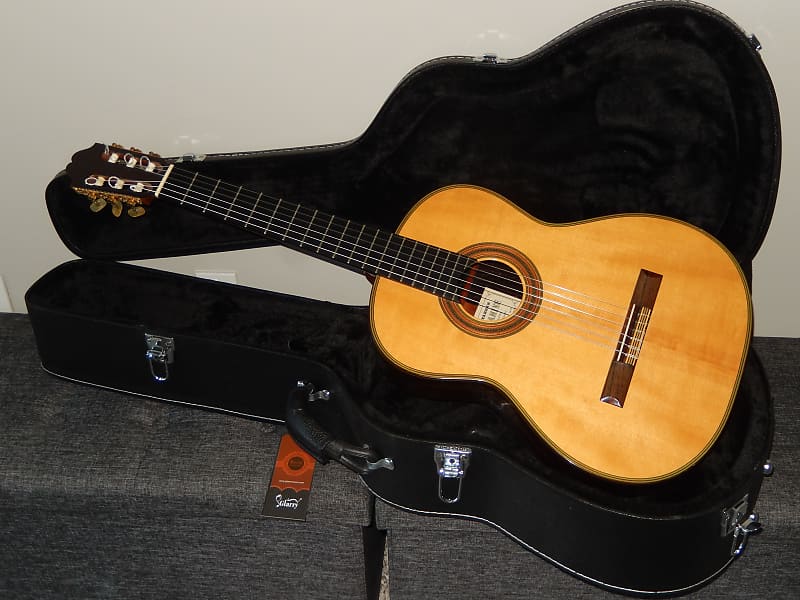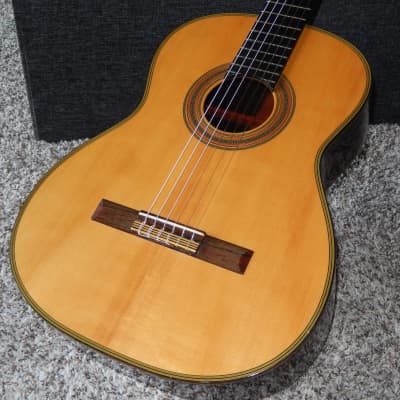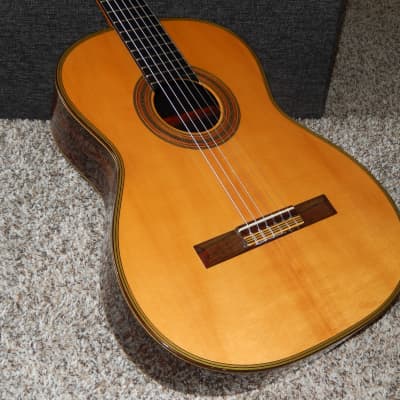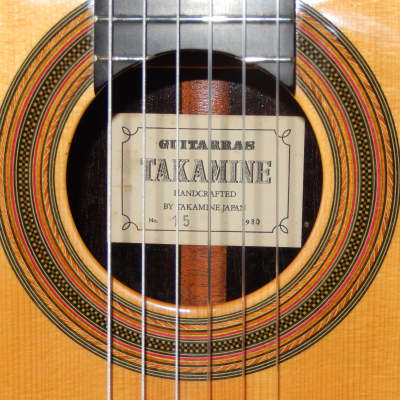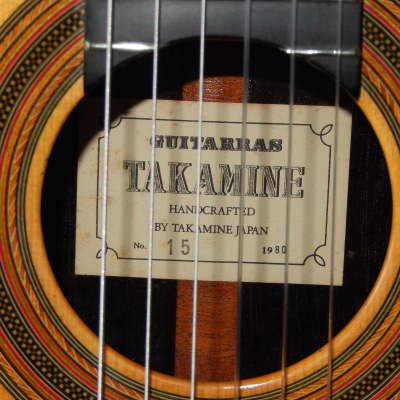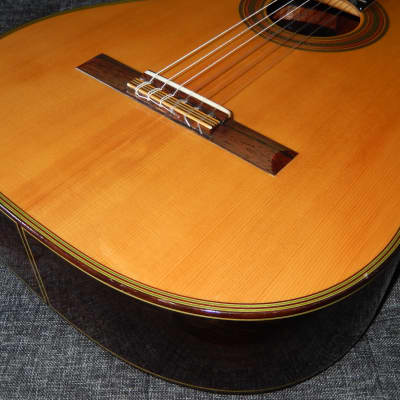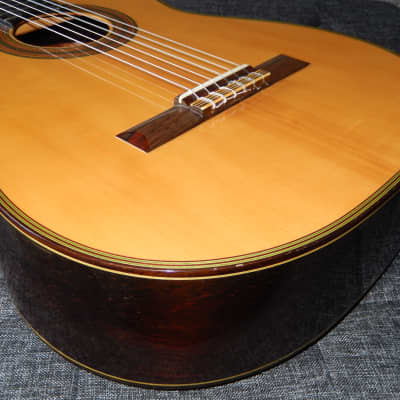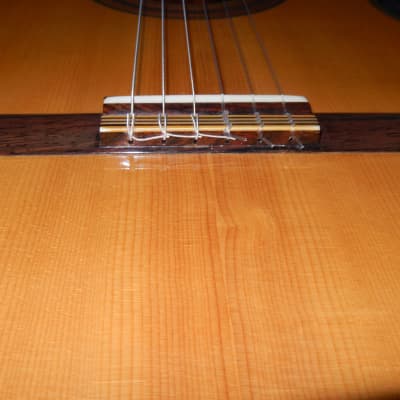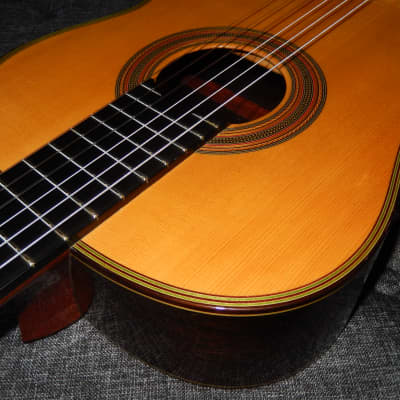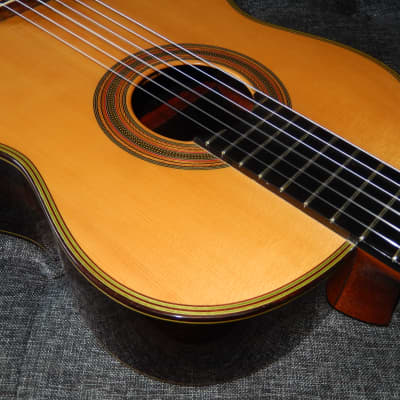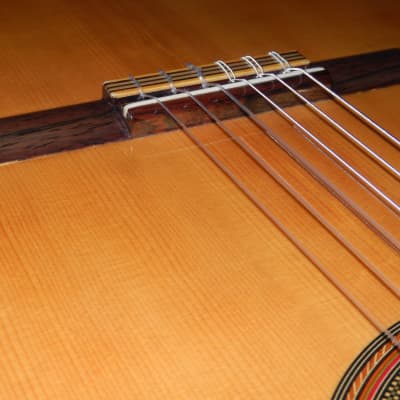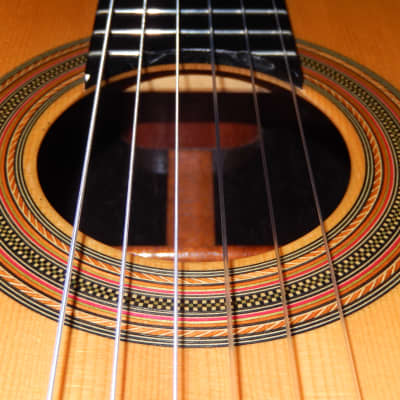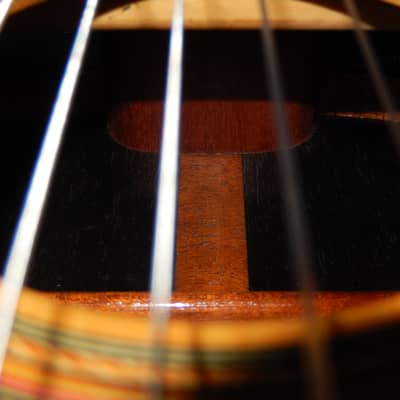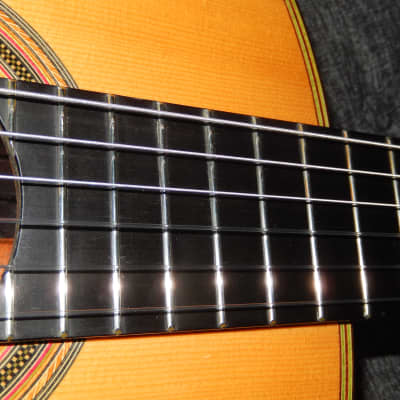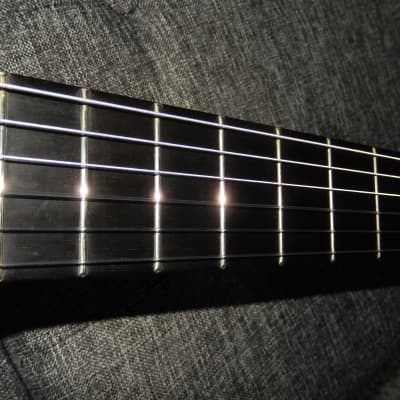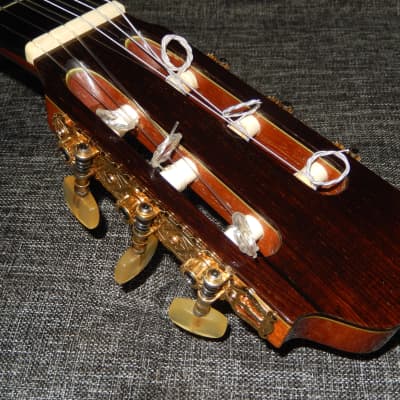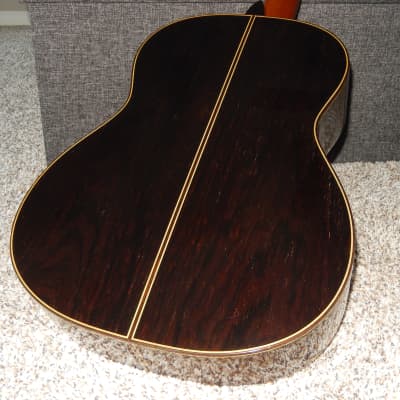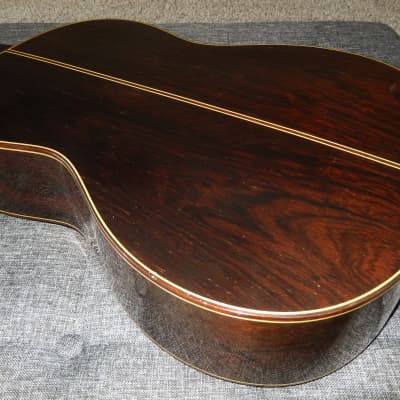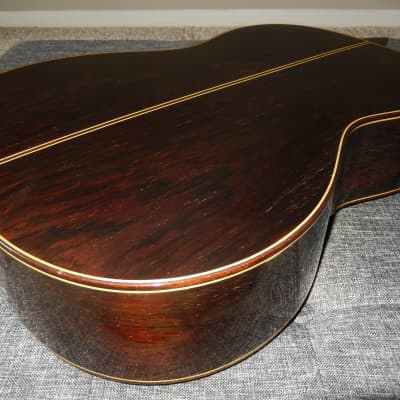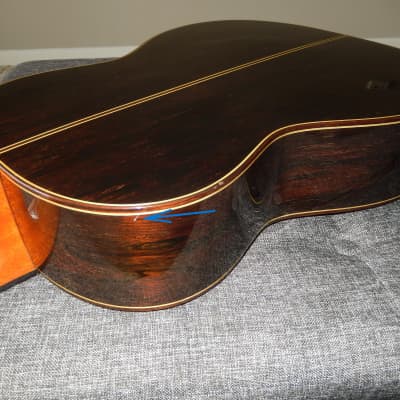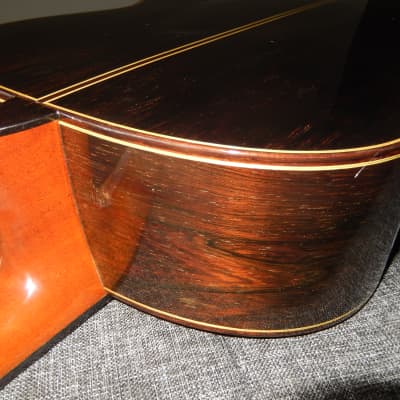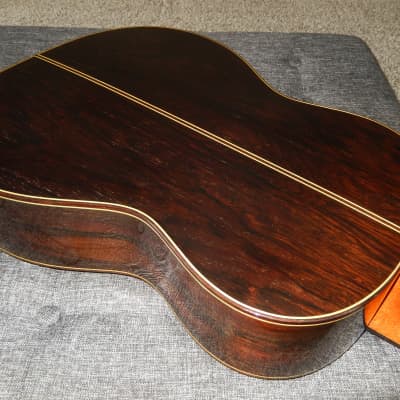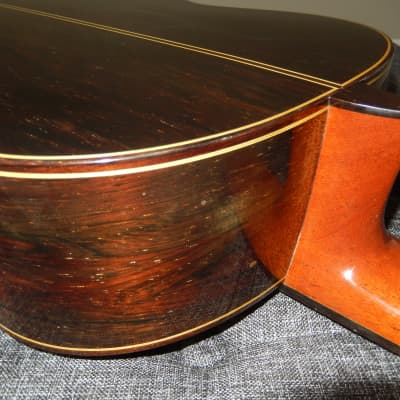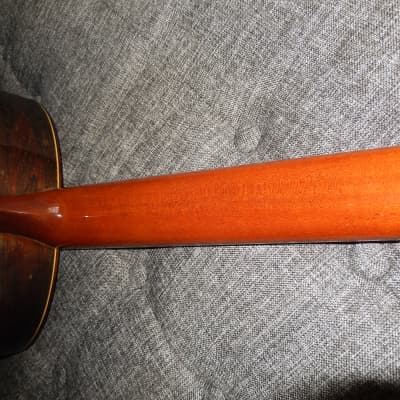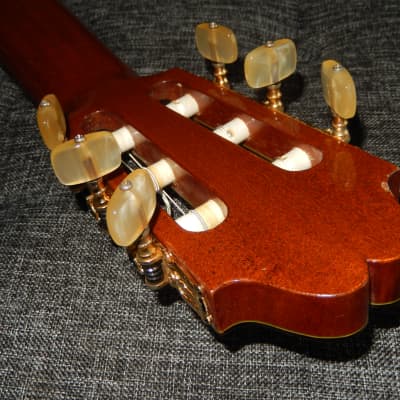Several hundred guitars I have sold in the past are presented at Facebook.com/Victors.Guitar.Library.
Takamine’s All Times Best No15 1980
The guitar was made in 1980 under the supervision of Takamine's Headmaster Luthier Masaichi Furui however inspired by blueprints provided by world famous luthiers. The bracing on this guitar is the same Antonio de Torres introduced in 1860. Multilayered purfling closely resembles Herman Hauser’s purfling. The headstock design matches Robert Bouchet’s headstocks.
In the past I have sold made in 1978 guitar of similar design labelled “Luthier M. Furui” by Takamine model No10. And now I also have very similar model 10 from 1984.
https://reverb.com/item/12680997-made-in-1978-by-m-furui-amazing-takamine-10-classical-grand-concert-guitar
https://reverb.com/item/67746033-made-in-1984-takamine-10-bouchet-torres-furui-style-classical-grand-concert-guitar
In Takamine’s classical guitar lineup of 1980 the highest model was No15 (priced 150 000yen) followed by models No10, 8, 7, 6, 5, 40, 30 and 20 (priced 20 000 yen). In the early 1980s that lowest model 20 was discontinued and the (new) model 20 became the highest one. It was very much the same class as model 15 from 1980, also made with solid BR b/s while model No15 was made with solid IR b/s. However, this model 20 was made with figured BR for just couple of years, and later made with straight grain BR or other Latin America Rosewoods. Also, around the year 1985 the construction of Takamine guitars was again based on Masaru Kohno designs, with his style rosettes and bridge decoration on high end models (10,15,20). Model 20 was the top of the line until the late 1990s. In early 2000s model 20 was replaced by model 25 made with Madagascar Rosewood b/s (although some Japanese experts say that it was initially made with figured BR b/s). By the late 2000s model 25 was replaced by model No39. The currently manufactured Takamine No39 sounds like a toy compared to model 20 from early 1980s or this No15 from 1980.
https://reverb.com/item/15199443-made-in-mid1980s-sweet-powerful-takamine-15-classical-grand-concert-guitar
https://reverb.com/item/36243749-made-in-2006-top-of-the-line-takamine-25-classical-grand-concert-guitar-madagascar-rosewood
https://reverb.com/item/13854539-made-in-2009-takamine-39-amazing-kohno-style-classical-grand-concert-guitar
This guitar you are now looking at is of the highest class ever made by Takamine. It can easily challenge guitars sold for twice that much (Masaru Kohno No30 1980, Yamaha GC30A, Sakazo Nakade 3000, Hiroshi Tamura 30 etc.) during the same era. But as of today, this guitar can easily challenge all guitars sold in USA for $15000. To my ears it represents the same high class as Yamaha’s flagship model GC70.
https://reverb.com/item/27615081-her-majesty-yamaha-gc70-highest-grade-japanese-made-classical-concert-guitar-brazilian-rosewood
This Takamine 15 1980 was very hard to find, and I have been hunting for it for the last 11 years. It is the second Takamine model made with solid figured Brazilian Rosewood b/s I have ever seen.
This terrific and powerful instrument certainly deserves the title of Grand Concert Guitar. This gorgeous instrument offers superb response, very impressive volume, depth, combined with sweet and very soothing tonality that easily challenges higher priced models made by Japanese elite luthiers of that era. Basses are relatively deep, rich with overtones but also focused and clean. Trebles are sweet, clear, and ringing like piano keys. While individual treble notes sound “crisp” in chords they sound way mellower, making the overall tonality of this Spruce top guitar only moderately bright. All notes are well balanced and well separated, all magnified by great sustain. It simply is a "joy to play" guitar.
While overall condition of this guitar can be described as “excellent for its age” its surfaces only few very minor cosmetic imperfections: few tiny dents along the edges, and couple very light scratches on the top, and one light scratch on its side (being the most “serious damage”. Some traces of cloudiness within the finish are a result of covering shellac with thin layer of lacquer. Despite these few imperfections, excellent condition of the neck, fingerboard and frets prove that this guitar has been played very little over its lifespan. Its original tuners still work fine.
Specifications:
Top: Solid Yezo Spruce / fan of 7 braces / thin coat of lacquer over shellac (French Polish)
Back & sides: Solid Brazilian Rosewood / thin coat of lacquer over shellac (French Polish)
Fingerboard: Ebony
Neck: Mahogany
Scale 650 mm
Width at Nut: 52 mm
Strings: Aranjuez Concert Silver Set 700 Low Gauge
Its action is set to 4.00 mm under E6 and 3.50 mm under E1 with practically no extra room on the saddle.
This guitar will be shipped in brand new hard shell case.
Takamine History.
Takamine Gakki was founded in 1962 and during its first few years of operations, it wasn’t considered as leading Japanese guitar manufacture. It all changed in 1968 when Masaru Kohno took this company “under his umbrella” (most likely be became its owner or co-owner) and his pupil Mass Hirade became its director and leading Master Luthier. Until late 1970s Masaru Kohno personally supervised guitar production at Takamine Co. Right after this transition in 1968 Takamine Gakki adopted ne guitar designs launching 3 series of guitars: Elite, TG and the most precious Yamato guitars (by early 1970s renamed to Aranjuez).
Elite series had Ramirez style headstock and Ramirez style bracing. TG series guitars kept old style Takamine headstock but also had Ramirez style bracing. Aranjuez guitars had Takamine’s unique design headstock (used on Takamine guitars until today) and Kohno style bracing (which is nothing but simple lattice bracing). American luthier & guitar importer (also manufacturer of Luthier & Aranjuez strings) Juan Orozco invested and was deeply engaged in creation of Aranjuez guitar brand, even though these guitars were made only for Japanese domestic market. The truth behind Aranjuez guitars is that right from the start they were designed to satisfy less wealthy Japanese guitar enthusiasts, who couldn’t afford guitars made by Masaru Kohno or other Japanese elite luthiers. Aranjuez guitar have always offered exceptional value for the money. The bodies of all models were made by Takamine workshop. Top Aranjuez models were being finished at Kohno workshop and equipped with soundboards made by Masaru Kohno or his associates. Traditionally the very top Aranjuez model was assembled personally by Masaru Kohno. These very top Aranjuez models were nothing but Kohno guitars priced 50% down. Aranjuez 7 made in 1973 was decisively better than Kohno #10 from the same year and could easily compete with Kohno #15. Aranjuez 720 (priced 200 000 yen) made in 2000 could easily compete with Kohno model Professional R (priced 450 000 yen). Until 1976 all Aranjuez guitars had Kohno stamp on their labels. Starting in 1977 Kohno stamp was no longer used on Aranjuez guitars, even though their production was still closely supervised by Masaru Kohno’s workshop.
In the same late 1970s Takamine Gakki launched new series of guitars named simply “Guitarras Takamine”. These “new” Takamine guitars had the same construction and looks as “old” Aranjuez guitars. The lower Takamine models 20,30 and 40 had their own unique rosettes, while higher models 5, 6, 7, 8, 10 had Kohno style rosettes. The very top Takamine models 15 & 20 had Kohno style purflings and Kohno style decorated bridge. This classical guitar lineup remained unchanged until late 1980s.
Since early 1980s bodies of Aranjuez guitar were made by Ryoji Matsuoka, while the very top model still assembled at Kohno’s and later (after Masaru Kohno’s death in 1998) at Masaki Sakurai/Kohno workshop. After Matsuoka’s workshop was closed in September of 2014, bodies of Aranjuez guitars are again made by Takamine co. while the very top Aranjuez 725 is assembled personally by Masaki Sakurai who also makes its soundboard all by himself. Just like in the early days of Aranjuez guitars this model 725 (priced 250 000 yen) is of the same grade as Masaki Sakurai model Concert R (priced 420 000 yen).
Real Value of Japanese Vintage Guitars
The key to understand value of vintage Japanese guitars is to acknowledge galloping price inflation (devaluation of Japanese yen) during 1960s & 1970s. This inflation slowed down in 1980s.
During 1960s and most of 1970s model numbers of Japanese guitars were strictly interconnected with their prices in Japanese yen. By early 1980s and during following decades model numbers were no longer strictly associated with their prices. Some Japanese guitar makers introduced model names instead of model numbers. Others were still using model numbers with addition of letters and/or other symbols.
It is important to understand that two Yamaha GC10 guitars made 10 years apart are two instruments of totally different class. The same applies to any other Japanese maker/brand.
Any guitar priced 100 000 yen in 1970 (labelled usually as No10) would be priced 200 000 yen in 1975 (relabeled to No20 or 2000), 300 000 yen in 1977 (labelled as No3, No30 or 3000). Starting in 1977 Masaru Kohno introduced his new models No40 priced 400 000 yen and No50 priced 500 000 yen. By 1984 Kohno started using model names instead numbers and was raising their prices as he was pleased. The very top model 50 became model “Special”, and a decade later it became model “Maestro”. Naturally, all other Japanese guitar makers were doing the same pricing (labelling) upgrades.
Knowing all of that, you can bet on that Masaru Kohno No50 made in 1982 is practically the same grade instrument as Kohno No20 made in 1972, or Kohno no 30 made in 1975.
In 1970 the lowest Ryoji Matsuoka (all laminates) model was 10, followed by (solid top) models 15, 20, 25, 30, 40, 50, 60, 80 and (all solid woods) models 100 and 150. Models 60 and 80 were made with non-solid figured Brazilian Rosewood (double) b/s and top model 150 was the only one made with solid figured Brazilian Rosewood b/s.
In 1980 the lowest Matsuoka model was (all laminates) 20, followed by (solid top) models 30,40,50, 60 and all solid woods models 80,100,150 and 200. By 1990 the lowest Matsuoka model was M40 and the highest was M300. By 2010 the lowest Matsuoka model was M50 and the top model was M270.
You can bet that Ryoji Matsuoka model 50 from 1980 is of the same grade as model M100 from 2000, model 100 from 1980 is of the same grade as model M150 from 2000, model 150 from 1980 is of the same grade as M200 from 2000 and model 200 from 1980 is of the same grade as model M300 from 2000.
It is important to mention that if modern era luthiers are using 40+ years old woods to make an “all solid” wood classical guitar, its price is minimum $8000.
All vintage guitars made with Brazilian Rosewood are especially precious, including those made straight grain varieties and those with non-solid b/s.
Because response and tonal properties of Spruce soundboards are improving over time, long seasoned Spruces are far more precious than long seasoned Cedars.
It is not that very difficult to find out what are current prices of such guitars made by world’s leading luthiers.
Important message for Australian buyers:
USPS International Priority Mail packages destined for Australia have quite restricted size (max. length is 42” and max. length + girth is 97”). For these reasons I must use the case that is no longer than 41” and therefore it may be different than the one you see on the pictures. You should ask me for any other details prior to making a purchase.
